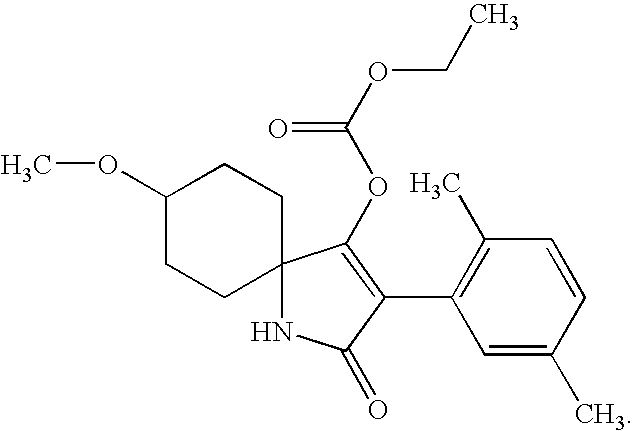Aqueous insecticidal compositions and the use thereof for protecting lignocellulose-containing materials
a technology of insecticidal compositions and lignocellulose, which is applied in the direction of biocide, phosphorous compound active ingredients, manufacturing tools, etc., can solve the problem of not being able to meet the application rate of active ingredients for effective protection, and achieve the effect of not being able to meet the application rate of active ingredients and ensuring the effect of material protection
- Summary
- Abstract
- Description
- Claims
- Application Information
AI Technical Summary
Benefits of technology
Problems solved by technology
Method used
Image
Examples
example 1
Dispersions D1 and D2
General Preparation Protocol:
[0171]465 g of deionized water, 5% by weight of feed 1 and 10% by weight of feed 2 were heated at 80° C. After 10 minutes, adding the remainder of feeds 1 and 2 was started. The feed time was 3.5 hours. After feeding had ended, the mixture was held for a further 30 minutes at 80° C. and then cooled to room temperature.[0172]Feed 1:[0173]496.1 g of deionized water[0174]7.6 g of sulfuric acid (50% by weight)[0175]361.0 g of methyl methacrylate[0176]19.0 g of dimethylaminoethyl methacrylate[0177]57.0 g of emulsifier solution E1[0178]x g of active ingredient (see Table 1)[0179]Feed 2:[0180]Solution of 1.5 g of 2,2-′azobis(N,N′-dimethylisobutyramidine) in 63.3 g of deionized water
[0181]Emulsifier solution E1: 40% by weight strength aqueous solution of a cationic emulsifier obtained by successive ethoxylation of stearylamine with 4-5 mols of ethylene oxide, followed by quaternization with dimethyl sulfate.
[0182]
TABLE 1DispersionActive ingr...
example 2
Dispersions D3 and D4
General Preparation Protocol:
[0184]465 g of deionized water, feed 1 and 10% by weight of feed 2 were heated at 80° C. After 10 minutes, adding the remainder of feed 2 and feed 3 was started. The feed time of feed 2 and feed was 3.5 hours. After feeding had ended, the mixture was held for a further 30 minutes at 80° C. and then cooled to room temperature.[0185]Feed 1:[0186]46.1 g of deionized water[0187]38.0 g of styrene[0188]7.6 g of 3-(N,N)-dimethylaminopropylmethacrylamide[0189]14.2 g of emulsifier solution E1 (see above)[0190]Feed 2:[0191]Solution of 1.5 g of 2,2-′azobis(N,N′-dimethylisobutyramidine) in 63.3 g of deionized water[0192]Feed 3:[0193]450.1 g of deionized water[0194]7.6 g of acrylic acid[0195]270.0 g of methyl methacrylate[0196]57.0 g of dimethylaminoethyl methacrylate[0197]42.8 g of emulsifier solution E1 (see above)[0198]x g of active ingredient (see Table 2)
[0199]
TABLE 2DispersionActive ingredientx [g]D3Chlorfenapyr61.8D4α-Cypermethrin42.9
[0200...
example 3
Dispersion D5
[0201]226 g of deionized water, 5% by weight of feed 1 and 10% by weight of feed 2 were heated at 80° C. After 10 minutes, adding the remainder of feeds 1 and 2 was started. The feed time was 3.5 hours. After feeding had ended, the mixture was held for a further 30 minutes at 80° C. and then cooled to room temperature.
[0202]Feed 1:
[0203]140.0 g of deionised water
[0204]3.0 g of H2SO4
[0205]22.5 g of emulsifier solution E1
[0206]30.0 g of styrene
[0207]112.5 g of methyl methacrylate
[0208]7.5 g of dimethylaminoethyl methacrylate
[0209]21.71 g of alpha-cypermethrin
[0210]Feed 2: 0.6 g of 2,2′-azobis(N,N′-dimethylisobutyramidine) in 25 g of water
[0211]The resulting dispersion had a solids content of 28.7% by weight and a viscosity of 100 mPa·s. The polymer had a glass transition temperature at 78.3° C., determined by means of DSC. The mean particle size determined by means of light scattering was 107 nm.
REFERENCE EXAMPLE
Anionic Dispersion D6 (Not According to the Invention)
[0212...
PUM
| Property | Measurement | Unit |
|---|---|---|
| mean particle size | aaaaa | aaaaa |
| solubility | aaaaa | aaaaa |
| glass transition temperature TG | aaaaa | aaaaa |
Abstract
Description
Claims
Application Information
 Login to View More
Login to View More - R&D
- Intellectual Property
- Life Sciences
- Materials
- Tech Scout
- Unparalleled Data Quality
- Higher Quality Content
- 60% Fewer Hallucinations
Browse by: Latest US Patents, China's latest patents, Technical Efficacy Thesaurus, Application Domain, Technology Topic, Popular Technical Reports.
© 2025 PatSnap. All rights reserved.Legal|Privacy policy|Modern Slavery Act Transparency Statement|Sitemap|About US| Contact US: help@patsnap.com



